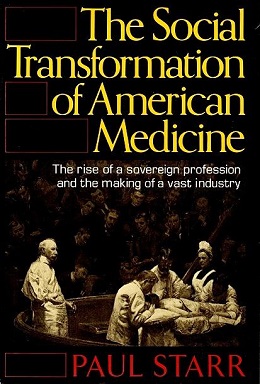The Social Transformation of American Medicine
The Social Transformation of American Medicine is a seminal book in the field of medical sociology and history of medicine in the United States. Written by Paul Starr, it was first published in 1982 and has since become a classic text, critically acclaimed for its comprehensive analysis of the evolution of the American healthcare system. The book explores the complex interplay between medical practice, the medical profession, and American society from the colonial period to the late 20th century. Starr's work is notable for its depth of research and its insightful analysis of the social forces that have shaped American medicine.
Overview[edit | edit source]
The book is divided into two main parts. The first part, "The Rise of Professional Sovereignty," traces the development of the medical profession in America, highlighting the transition from a fragmented and competitive market to a more organized and authoritative profession. This section delves into the establishment of medical licensure, the development of medical education, and the rise of medical institutions, such as hospitals and professional associations. Starr examines how these changes contributed to the medical profession's growing authority and autonomy.
The second part, "The Transformation of American Medicine," focuses on the shift from a system of private practice to a more complex system of medical care involving hospitals, insurance companies, and government programs. This section addresses the growth of medical technology, the expansion of health insurance, and the increasing involvement of the federal government in healthcare. Starr discusses the implications of these changes for the medical profession, patients, and American society at large.
Themes and Analysis[edit | edit source]
One of the key themes of The Social Transformation of American Medicine is the concept of professional sovereignty. Starr argues that the medical profession's quest for autonomy and control over medical practice has been a driving force in the evolution of American healthcare. He also explores the tension between the ideals of medical professionalism, such as altruism and service to the community, and the economic interests of physicians.
Another important theme is the impact of social, economic, and political forces on the healthcare system. Starr highlights how changes in these areas have influenced the organization, delivery, and financing of medical care. He also addresses the role of technology in transforming medical practice and the healthcare industry.
Reception and Impact[edit | edit source]
Since its publication, The Social Transformation of American Medicine has received widespread acclaim and has won several awards, including the Pulitzer Prize for General Non-Fiction and the Bancroft Prize in American History. It is considered a landmark work in the fields of medical sociology and the history of medicine.
The book has also had a significant impact on the study of healthcare systems and policy. It has been used as a key text in academic courses and has influenced research in the field. Starr's analysis of the social dynamics of the medical profession and the healthcare system continues to be relevant in discussions about healthcare reform and the future of medicine in the United States.
See Also[edit | edit source]
Navigation: Wellness - Encyclopedia - Health topics - Disease Index - Drugs - World Directory - Gray's Anatomy - Keto diet - Recipes
Search WikiMD
Ad.Tired of being Overweight? Try W8MD's physician weight loss program.
Semaglutide (Ozempic / Wegovy and Tirzepatide (Mounjaro) available.
Advertise on WikiMD
WikiMD is not a substitute for professional medical advice. See full disclaimer.
Credits:Most images are courtesy of Wikimedia commons, and templates Wikipedia, licensed under CC BY SA or similar.
Contributors: Prab R. Tumpati, MD

